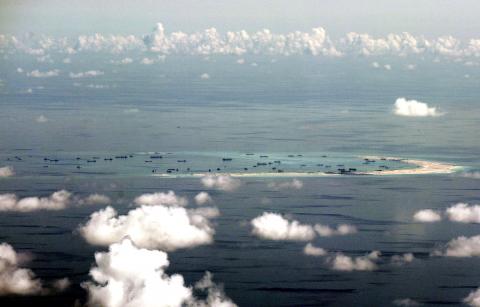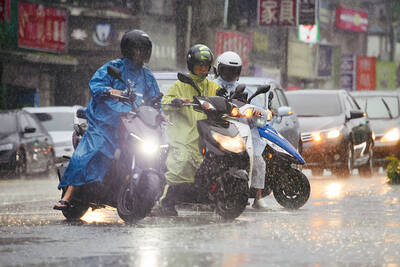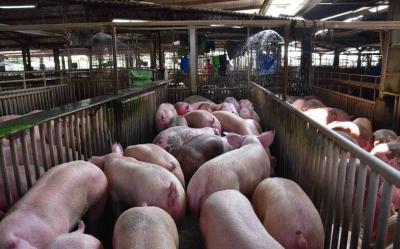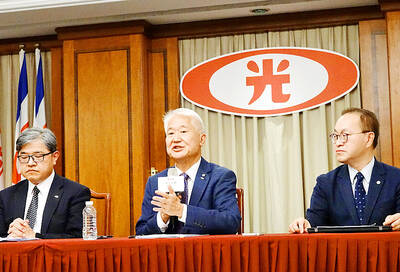China could use militarized islands in the South China Sea to stop the US from helping Taiwan in a crisis, a Washington conference was told.
The US is “quite concerned” the islands will increase China’s anti-access area-denial and general power-projection capabilities, said Bonnie Glaser, senior adviser for Asia at the Center for Strategic and International Studies (CSIS).
“This, of course, depends what equipment, what platforms China deploys,” Glaser said.

Photo: AP
Glaser said that potentially there could be surface-to-air missiles, anti-ship cruise missiles, manual and automatic aircraft and surface combatants.
She said runways would support refueling operations that would substantially extend the operational ranges of Chinese aircraft.
They could provide the capability to hold US forces at risk at a further distance than at present,” Glaser said.
A consultant for the US government on East Asia, she said US access to the region could be hindered if the US were seeking to defend Taiwan in a crisis.
“US ability to maneuver within the region would be potentially affected,” she told the fifth annual CSIS South China Sea Conference this week.
Glaser said that the most “prominent and problematic” development in the South China Sea over the past year had been China’s transformation of submerged or semi-submerged rocks and reefs into artificial islands.
She said the first Chinese objective was to assert sovereignty and administrative control.
Satellite imagery shows an “enormous amount of construction” and a good deal of it potentially for military facilities, Glaser said.
“This includes harbors, the very long runway — more than 3,000m — on Fiery Cross Reef [Yongshu Reef, 永暑礁], potentially hangers for aircraft — although I don’t think we have seen that yet — radars, other capabilities that will enable China to increase the size and the scope of its maritime presence.”
Taiwan also claims the reef.
Glaser said that China had about eight coast guard ships generally operating in the South China Sea at any given time and had limited capability to conduct intelligence, surveillance and reconnaissance.
However, “these would increase substantially with the use of these artificial islands, including electronic eavesdropping, potentially operating AWACS [Airborne early warning and control],” she added.
There is also the potential for China to establish an air defense identification zone, as it has done in the East China Sea, she said.
“It’s possible that, in order to monitor and enforce such a zone effectively, that China might really need more than one runway,” Glaser said. “Now it has one in the Paracels [Paracel Islands, Xisha Islands, 西沙群島] and will soon have one operational in the Spratlys [Spratly Islands, Nansha Islands, 南沙群島]. The satellite imagery of Subi Reef [Jhubi Reef, 渚碧礁, in the Spratlys] shows the potential for building another runway there.”
Taiwan also claims the Spratlys and Paracels.
She said that some people dismiss the military value of the artificial islands, because the islands would be vulnerable to attack in wartime.
However, “of course, in peacetime as well as in crisis, they do have potential value,” Glaser said.

The combined effect of the monsoon, the outer rim of Typhoon Fengshen and a low-pressure system is expected to bring significant rainfall this week to various parts of the nation, the Central Weather Administration (CWA) said. The heaviest rain is expected to occur today and tomorrow, with torrential rain expected in Keelung’s north coast, Yilan and the mountainous regions of Taipei and New Taipei City, the CWA said. Rivers could rise rapidly, and residents should stay away from riverbanks and avoid going to the mountains or engaging in water activities, it said. Scattered showers are expected today in central and

COOPERATION: Taiwan is aligning closely with US strategic objectives on various matters, including China’s rare earths restrictions, the Ministry of Foreign Affairs said Taiwan could deal with China’s tightened export controls on rare earth metals by turning to “urban mining,” a researcher said yesterday. Rare earth metals, which are used in semiconductors and other electronic components, could be recovered from industrial or electronic waste to reduce reliance on imports, National Cheng Kung University Department of Resources Engineering professor Lee Cheng-han (李政翰) said. Despite their name, rare earth elements are not actually rare — their abundance in the Earth’s crust is relatively high, but they are dispersed, making extraction and refining energy-intensive and environmentally damaging, he said, adding that many countries have opted to

African swine fever was confirmed at a pig farm in Taichung, the Ministry of Agriculture said today, prompting a five-day nationwide ban on transporting and slaughtering pigs, and marking the loss of Taiwan’s status as the only Asian nation free of all three major swine diseases. The ministry held a news conference today confirming that the virus was detected at a farm in Wuci District (梧棲) yesterday evening. Authorities preemptively culled 195 pigs at the farm at about 3am and disinfected the entire site to prevent the disease from spreading, the ministry said. Authorities also set up a 3km-radius control zone

CONCESSION: A Shin Kong official said that the firm was ‘willing to contribute’ to the nation, as the move would enable Nvidia Crop to build its headquarters in Taiwan Shin Kong Life Insurance Co (新光人壽) yesterday said it would relinquish land-use rights, or known as surface rights, for two plots in Taipei’s Beitou District (北投), paving the way for Nvidia Corp to expand its office footprint in Taiwan. The insurer said it made the decision “in the interest of the nation’s greater good” and would not seek compensation from taxpayers for potential future losses, calling the move a gesture to resolve a months-long impasse among the insurer, the Taipei City Government and the US chip giant. “The decision was made on the condition that the Taipei City Government reimburses the related